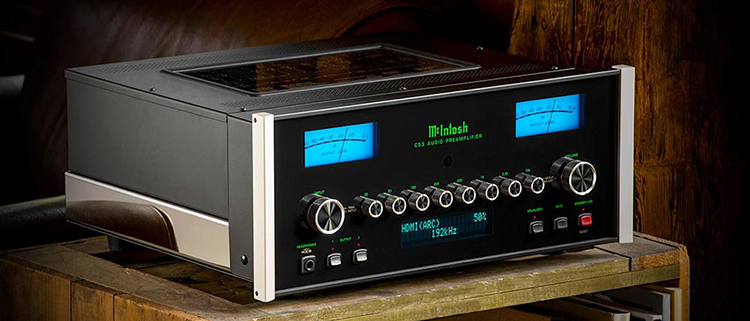
McIntosh has always made great preamps, and their latest solid-state flagship not only carries on the tradition but does so with a full eight-band analog equalizer! One might fear that the full feature set provided with the C53 would interfere with the preamplifier’s tonality or transparency. Nope – This preamp runs with the best in the business in both categories. If you want McIntosh’s flagship stereo preamplifier, the C53 is for you!
The McIntosh C53 Stereo Preamplifier brings an exceptional level of control to a prospective owner without sacrificing sound quality. This is a difficult achievement because more active circuitry increases the risk of damage to the sound’s delicacy, flat frequency response, and imaging. This is why the majority of audiophile preamplifiers cling to the straight-wire-with-gain design philosophy. But McIntosh, ever the rebel, still offers this control center design that competes at the very top level. With but minor quibbles, this is one of the very best preamplifiers you can buy.
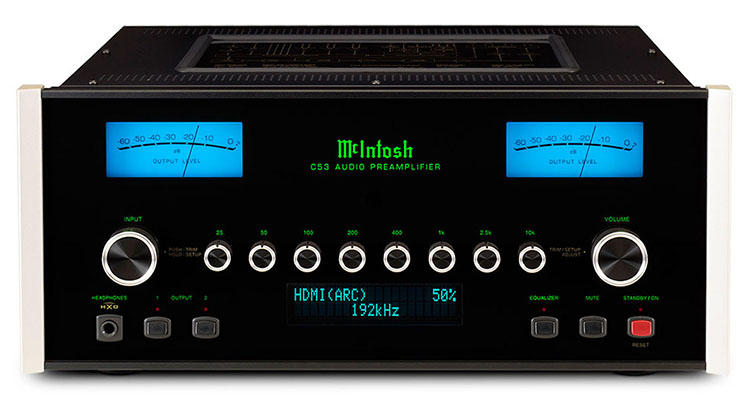
Mcintosh C53 Stereo Preamplifier
- Traditional McIntosh design and construction
- Exceptional sound
- Included eight-band analog equalizer
- Glowing blue VU meters
- DA-2 Digital Audio Module is included
- AV bypass is included
I’ve always been a fan of McIntosh preamps, and that now includes the McIntosh C53 Stereo Preamplifier. I once purchased a used C41 from a local priest and he must have blessed that unit because it had the most heavenly sound! The McIntosh C53 stereo preamplifier carries on in that tradition. Since that strongly positive introduction to McIntosh, I’ve always enjoyed the sound of the company’s preamplifier offerings.
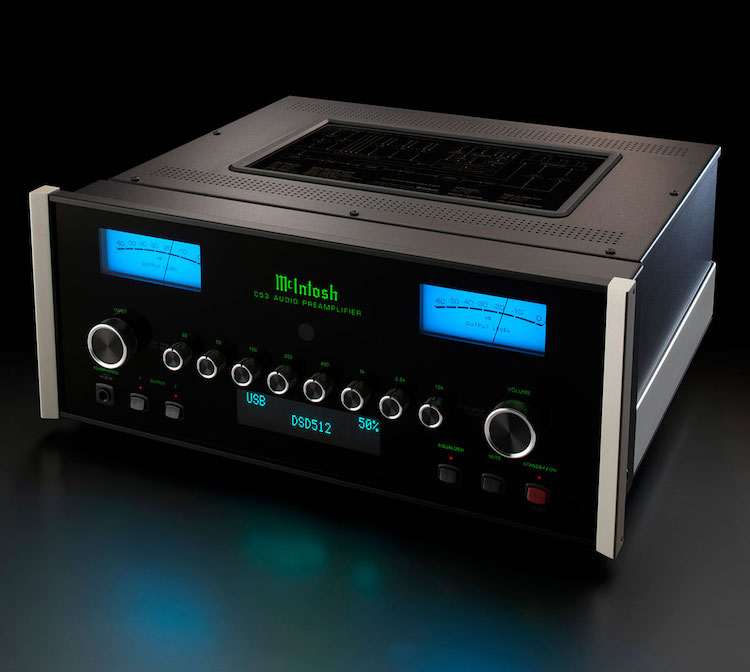
But McIntosh isn’t only famed for their sound. They are one of the few companies that maintain a large number of authorized service facilities and are able to clean, repair, and refurbish almost any of their products, including most discontinued models. The McIntosh C53 stereo preamplifier is unlikely to need service for a very long time but having the support to actually service the component per its warranty when needed is a strong buying incentive.
ELECTRONIC SPECIFICATIONS
Number of Channels:
2 (Stereo only)
Maximum output voltage (XLR / RCA):
16v RMS / 8v RMS
Phono Sensitivity (Moving Magnet / Moving Coil):
4.5mv / 0.45mv
Phono Signal to Noise Ratio (Moving Magnet / Moving Coil):
82dB / 80dB
Phono Voltage Gain (Moving Magnet / Moving Coil):
40dB / 60dB
Total Harmonic Distortion:
0.005%
Line Level Sensitivity (XLR / RCA):
900mv / 450mv
Line Level Signal to Noise Ratio:
100dB
Line Level Voltage Gain:
15dB
Input Impedance (XLR / RCA):
44k ohm / 22k ohm
Frequency Response (20-20kHz):
+0, -0.5dB
Frequency Response (15-100kHz):
+0, -3dB
CONNECTIVITY
Total Inputs (analog / digital):
16 (9 / 7)
Analog / Digital Compatibility:
Roon Designation
XLR Inputs:
3
RCA Inputs:
4
Phono Inputs (Moving Magnet):
1 (adjustable)
Phono Inputs (Moving Coil):
1 (adjustable)
Digital Audio Module (included & upgradeable):
Yes – DA2
Digital Coaxial Inputs:
2
Digital Optical Inputs:
2
Coax / Optical limits:
24/192kHz
Digital MCT (DIN) Input:
1
Compatibility with other MCT McIntosh components:
SACD/CD
Digital USB input:
1
USB limit:
DXD384K
HDMI (ARC) input/output:
1 (audio only)
Digital AES/EBU input:
0
Digital Capability:
Up to DSD512
Fixed Output (XLR / RCA):
0 / 1
Variable Output (XLR / RCA):
3 / 3
Headphone Output (1/4” High-Drive):
1
Headphone mix capability (Crossfeed Director):
HXD
Input Level Match:
Yes (+/- 6dB)
Home Theater Pass-Through:
Yes
Unbalanced Analog Connector Type:
Gold-Plated Brass
Service Port:
1
CONTROLS
Tone Controls:
8-band (+/- 12dB)
Tone Control Technology:
Sealed Rheostat
Tone Bypass:
Yes
Input Assign:
Yes
RS232 (serial port) Control Input:
Yes
Power Control Output:
1 Main / 4 Trigger
Rear Panel Data Port:
6
Rear Panel IR Remote Sensor Input:
Yes
GENERAL SPECIFICATIONS
Chassis Type:
Single, two-layer
Output Meters:
Yes
Vacuum Tube:
No
Online Power Consumption:
30 Watts
WEIGHT AND DIMENSIONS
Dimensions (W x H x D) English:
17.5” x 7.6” x 18”
Dimensions (W x H x D) Metric:
45 x 19 x 46cm
Weight (English / Metric):
28lbs / 12.5kg
Shipping Weight (English / Metric):
43.5lbs / 19.7kg
Warranty:
3-year Limited
MSRP:
$8,000.00 USD
Website:
Company:
SECRETS Tags:
Preamplifier Reviews, 2020, Control Center, McIntosh C53, McIntosh, Preamplifier Review 2020
- McIntosh MX-123 AV Processor
- McIntosh DA2 digital-to-analog converter introduction
- McIntosh C49 Stereo Preamplifier
- McIntosh D1100 Stereo Digital Preamplifier
If my Audio-gd HE-1 preamplifier was the epitome of the straight-wire-with-gain school of preamp design, then this McIntosh C53 is its polar opposite. The McIntosh C53 stereo preamplifier is the ultimate example of the preamplifier-as-control-center school of thinking. McIntosh has used a generous design budget and the newest technology to offer input/output switching via reed relays. The volume-control function is also designed to function without loss of sound quality or degradation over time.
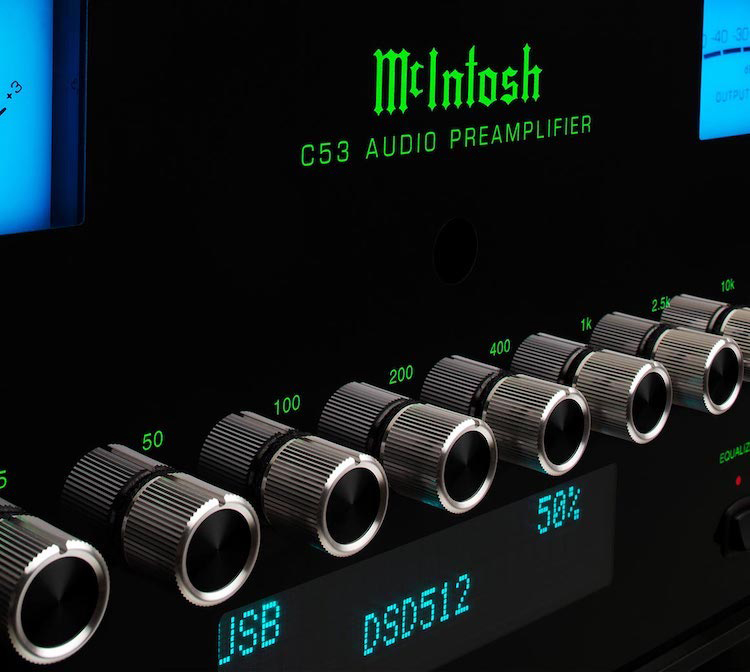
Historically, analog volume and tone controls have been implemented with the use of wiper and conductive-strip rheostats. After a few years of service, the mechanical contacts degrade due to atmospheric dust deposition and corrosion, and the rheostats become noisy (often with crackling and popping sounds).
The McIntosh C53 avoids that degradation by using an optical encoder that controls an integrated-volume-circuit via the main microprocessor. Degradation is avoided in the equalizer section by using sealed pots that reject environmental dust and moisture.
McIntosh equipment is generally known for its excellent reliability and engineering that is rarely found in other brands. In fact, the longevity of McIntosh gear is one of the main reasons that consumers are willing to pay for it. McIntosh backs up their goods with a large network of authorized repair centers. In fact, despite ownership changes over the decades, McIntosh is still one of the best-supported brands in audio.
Although the McIntosh “limited three-year warranty” on the C53 will expire long before the unit is ever likely to need service, having those authorized service centers available certainly adds to the preamplifier’s value.
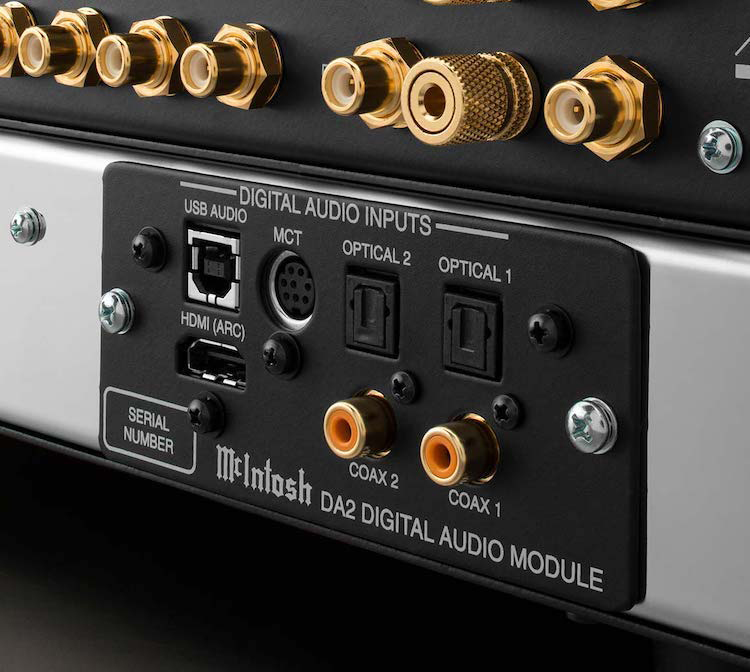
The DA-2 digital input card of the McIntosh C53 preamplifier uses the ESS 9028 PRO decoder chip. To get a handle on the sound of this DAC, I compared it to the Sabre DACs in my OPPO UDP-205 universal disc player and to my Audio-gd DAC-19. I used the balanced (XLR) analog outputs of the OPPO to feed the C53 and the unbalanced (RCA) outputs of the Audio-gd DAC-19. I also connected to the C53’s DAC itself via S/PDIF coaxial and optical TOSLINK.
The DA-2 card sounded very dynamic and neutral compared to the other DACs I have in house. The Audio-gd DAC-19 sounded the most relaxed (at the cost of dynamics and jump factor), the McIntosh DA-2 sounded the most accurate, and the OPPO’s Sabre DAC implementation sounded the brightest. To my ears, the end result in sound quality was nearly a toss-up between the OPPO and the McIntosh DA-2, but with a slight edge to the McIntosh. So overall, the excellent DA-2 DAC card is definitely a deserving mate to the C53!
Now, this brings me to a minor criticism. I would have preferred that the DA-2 be equipped with an Ethernet port for streaming. It isn’t. It’s fine that the optical TOSLINK port and the S/PDIF coaxial port both have Roon-ready designations, but the majority of Roon users stream audio over a home network and having a Roon-compatible hard-wire input on the DA-2 would have eliminated the need for another conversion (Ethernet to one of the DA-2’s input options) in the signal path. But despite this omission, I think that most users will be happy with the DA-2’s USB and HDMI inputs. Personally, I would use the HDMI port – it sounded better to me than the optical TOSLINK input.

The McIntosh C53 remote has the capacity to control multiple components, but I used it solely for the preamp. Everything worked fine, but I wish that McIntosh had made the remote backlit. Then it would be easier to find in a darkened listening room.
The supernatural attraction of big, blue meters… One of the most well-known and beloved trademarks of the McIntosh corporation is their use of dual VU (Volume Unit) meters that are illuminated by an unearthly blue glow. A VU meter is essentially a voltage meter calibrated to give a reading of 0VU at a sine wave’s maximum voltage. Traditionally, the meters have been most prevalent on McIntosh power amplifiers but recognizing the sales value of this readily-recognizable brand identifier, McIntosh has previously used them on other preamps and has opted to incorporate them into the C53 preamplifier as well. The vast majority of potential purchasers will happily approve! Although the meters do not improve sound quality, neither do they decrease it.
About warranty
- The limited, 3-year McIntosh warranty is valid only if you purchase your C53 directly from an authorized dealer. This is done to discourage grey-market sales over the internet.
- The warranty is non-transferrable and remains valid for the original owner only.
- The direct warranty from McIntosh applies only if your purchase is made in the United States or Canada. In all other countries, the warranty is provided directly by the authorized distributor.
- The glass faceplate is not covered under warranty unless it is broken at the time of sale.
- The owner must submit the original sales receipt to qualify for warranty work (no photocopies).
- The owner must pay for both delivery and return shipping to and from the authorized repair station.
Of course, for the vast majority of C53 owners, the warranty will be totally academic; the odds of any McIntosh product failing during the warranty period are truly minuscule. In fact, McIntosh is one of the few brands you can will to your grandchildren, and the components will probably still meet their factory specs.
The headphone enhancement system – The McIntosh C53 has an HXD Crossfeed Director that is intended to enhance headphone listening. I tried it and found the effect quite pleasant. Since it is easy to switch back and forth between active and bypass, you can decide for yourself. The owners’ manual doesn’t go into detail about how the HXD option works or what it does, but it’s definitely worth trying. Another convenience is that when headphones are plugged into the ¼-inch diameter jack on the front panel of the C53, the amplifier outputs are automatically muted. And I should also mention that the headphone amp in the C53 is designed for headphones of between 100 and 600 ohms impedance. But even when I used 40-ohm headphones, or when I cranked the volume, the headphone amp never sounded distorted or clipped. So overall, I’d give very high marks to the C53’s headphone section.
And now seems as good a time as any to describe the system in which the C53 was auditioned:
- Roon software operating on a Windows 10 server connected via Ethernet to
- OPPO UDP-205 (used as a DAC or as a digital pass-through – Ethernet to S/PDIF Coaxial)
- Audio-gd DAC-19 (S/PDIF coaxial input to unbalanced analog out)
- McIntosh C53 preamplifier (used with balanced/unbalanced analog inputs or with S/PDIF digital input)
- (2) self-powered subwoofers (Emotiva Airmotiv S-15s)
- (2) Emotiva PA-1 monoblock class-D power amplifiers or
- Klipsch RP-600M bookshelf loudspeakers or
- Emotiva T2 tower loudspeakers
- Speakers were either run full range with subs cut in below the roll-off frequency or else crossed over at approximately 100Hz by a modified Dahlquist DQ-1LP electronic crossover (unbalanced) or an NHT X1 crossover (balanced)
Note that while none of the associated equipment is in the same price class as the McIntosh C53 under review, the majority of it fits into the “overachiever” category. The system as a whole is also sufficiently revealing that I can easily hear differences. It is, therefore, more than adequate for reviewing purposes.
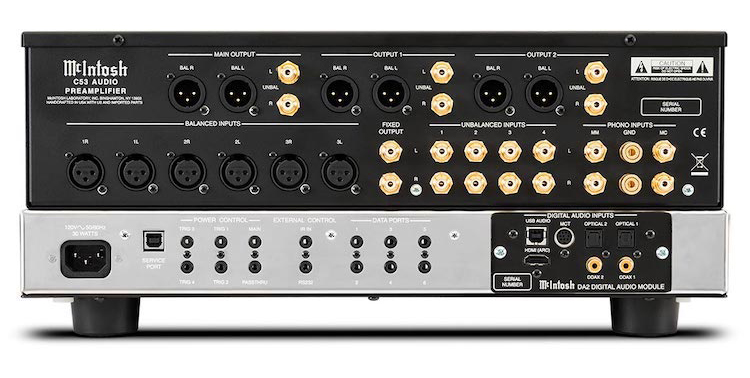
In addition to having a home theater bypass, the McIntosh C53 offers both balanced XLR inputs and outputs; and unbalanced RCA inputs and outputs. Despite this, the preamplifier’s internal circuitry is unbalanced. For home use, this is perfectly acceptable. The C53 is dynamic, transparent, and absolutely lovely-sounding.
The array of I/O options does trigger one minor complaint. More and more audiophiles these days are using satellite-subwoofer systems as their primary listening rigs, and the McIntosh C53 offers no bass management. This would be acceptable if McIntosh also offered an external electronic subwoofer crossover, but they have no such products currently available and on inquiry, said that they had no plans to offer any in the foreseeable future.
This puts the C53 user in the position of having to shop for a non-McIntosh external stereo crossover that can provide bass management. Of course, one could theoretically run the satellite speakers full range and use the subwoofers’ plate amplifiers as low pass filters, but this would negate the main advantage of bass management in the first place – elimination of low-frequencies from the main speakers.
But a good thing about the plethora of outputs on the C53 is that you can hook up your power amplifiers on a balanced output pair, and your subs on an unbalanced pair. Or if both your subs and amplifiers use identical inputs, you can use the second or even third pair of C53 outputs to simultaneously drive both without the need for splitter adapters.
After about four days of playing music to break in the C53, I sat down for some serious listening. Initially, I wanted to adjust the equalizer to see what improvements could be made in the sound, but the vast majority of my listening was done with the equalizer bypassed.

The McIntosh C53 preamp did just fine with Camille Saint-Saëns No. 3 “Organ Symphony.” And it did so even without using the 25Hz tone control. However, with the equalizer adding about a 4 or 5dB boost at that frequency, the organ absolutely shuddered the listening room. Be careful with this 25Hz boost ability. Injudicious boost can overload your amplifier, blow your speakers, and/or frighten your neighbors!

The Pine Valley Cosmonauts’ classic “The Majesty of Bob Wills” has many gems, but one of my favorites is “Across The Alley From The Alamo.” The rollicking bass line should roll out smoothly, with no notes sticking out from the rest. And if they do, the C53’s equalizer will tuck them right back in place again.
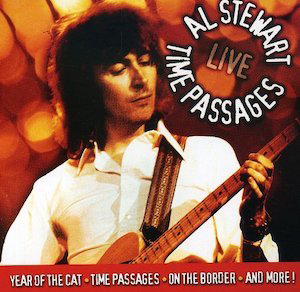
The live performance of “On The Border” by Al Stewart provides an ethereal-sounding guitar solo prior to the advent of crowd noise and vocals. It’s a rare preamplifier than can offer both the transparency of the guitar and the realism and opening of the sound stage that occurs when the applause begins. The McIntosh C53 was more than up to the task and threw a wide and deep sound stage.

“Fadeaway” by the Bo Deans is yet another cut that should provide an ethereal sound stage. All instrumental sounds should be crystal clear, and vocals should come through with startling dynamics. It should be readily apparent that much, if not all, of the recording was made in a HUGE venue (outside?) where the crowd noise virtually surrounds you. The McIntosh C53 (without any equalization) presented this music as well as I’ve ever heard it.

“The Syncopated Clock” and “The Typewriter Song” by Leroy Anderson test the transient response of any system. This is especially true when the percussive sounds are reduced in volume compared to the accompanying orchestra. With the C53, the transients are never swamped by or lost in the music.

“Hop, Hop, Hop” from Goran Bregovic’s disc, “Tales & Songs From Weddings & Funerals” is one of those ear-worms that are hard to shake. There’s a lot going on in this mix, so a good preamp shouldn’t blur the details. McIntosh C53 doesn’t. Not only do the circuits maintain discreet separation, but also the vocals are live-sounding as though they are both breathy and present in the room with you.
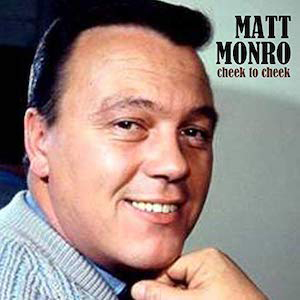
“Cheek to Cheek” by Matt Monroe out-croons just about all of them. The orchestra should be relaxed, and Matt Monroe’s voice should be dynamic and full. The C53 displays the entire song in its full glory. On my system, a slight touch of the 10kHz equalizer made this already-sparkly sounding track sound even sparklier.
So, to summarize the listening section of this review, I find absolutely nothing to complain about with the McIntosh C53’s sound. It’s ALL good! This is surprising in a full-control-center design, but the sound competes with the best I’ve heard despite the complexity of its design. Bravo McIntosh!

The $8,000 MCINTOSH C53 STEREO PREAMPLIFIER combines superb construction with only a few minor design shortcomings. Its fantastic sound and full control features make it unique.
- Eight-band equalizer allows for precise room correction
- Volume, input switching, and equalizer controls designed for reliability
- Beautiful McIntosh looks
- Very high-quality DAC included
- Exceptionally pure and clean voicing
- Great transparency and imaging
- Availability of authorized repair center network
- Home Theater bypass included
- Strong headphone amp with HXD enhancement
- Traditional blue VU meters
- Addition of Roon-Ready Ethernet streaming directly to the DAC
- Longer warranty
- Built-in bass management for subwoofer control
- Movement-activated back-lighting for the remote control
- Fully quad-balanced circuitry as on the MC-462 and the MC2KW
Even with its very few flaws, none of which are sonic, I rate the McIntosh C53 as one of the best preamplifiers I’ve ever heard or used in my system. The minor issues I found – lack of bass management, lack of quad-balanced circuitry, non-backlit remote, and lack of an Ethernet input may be completely academic to you. But unfortunately for me, these niggling shortcomings and the princely price of this preamplifier put it beyond my serious consideration.
But I’m not you. If you already have a McIntosh system or are in the process of building one, this is McIntosh’s best solid-state, stereo preamplifier. The fact that it has a home-theater pass-through mode and so many other great features might well persuade you (or even me, were I in your shoes) that the component justifies its price.



